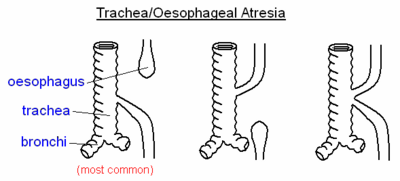Trachea
Structure and Function
Structure
It's a mobile tube (ie. It can get moved around). It has the rings of hyaline cartilage to keep it open. It starts in the neck just below the cricoid cartilage of the larynx at the level of the body of the sixth cervical vertebrae.
It diverticulates (divides) into the left and right bronchi. The bifurcation (division) is called the carina (think the 'keel' of a boat). The right one is more vertical than the left, and so that's where the peanuts go when people choke to death.
Functions
- Support and supply: the cartilage prevents kinking, collapse and obstruction, but the absence of it at the back allows to the trachea to shrink in swallowing and coughing and the like.
- The mucociliary escalator: all the cilia regularly beating send the mucus with adherent particles (all the muck) upwards to the larynx where it is swallowed or otherwise removed.
- Coughing: the trachea muscles suddenly contract along with abdo and other resp muscles to force the air out suddenly.
And so people can choke to death on peanuts.
Arterial and Venous supply
It mainly comes from the inferior thyroid arteries in the neck, and the bronchial arteries at the bottom. It drains into the bronchial veins. Not going to come up (I hope).
Nervous Supply
Branches of the vagus and the recurrent laryngeal nerves and from the sympathetic trunks. And at the bottom (next to the bifurcation) by the pulmonary plexus.
Lymph
I'm guessing they drain into the pretracheal and paratracheal lymph nodes. Anyone actually know, please email me.
Histology
Rigid and non collapsible due to horseshoes rings of cartilage. A strip of the posterior wall lacks cartilage, but contains dense fibrocollagenous ligament rich in elastic fibres and smooth muscle, which allows some constriction of the tracheal lumen – though no dilation. Mucosa is PSEUDOSTRATIFIED CILIATED COLUMNAR EPITHELIUM which if you haven't realised is respiratory epithelium by now, you're just not paying attention
Clinical Conditions
Atresia
You might remember this one from the oesophagus. Its an embryological condition. The oesophagus and trachea start off as one tube, and then split up. Sometimes this goes wrong, and the oesophagus leads into the trachea. Presents as coughing and choking on eating in very young babies, often with right lower lobe pneumonia.
Compression
In the neck, if there is a growth or enlargement of the thyroid gland, this can displace and/or compress the trachea. Further down, if the aortic arch has dilated (most often in an aneurysm) then the trachea may be compressed. With each cardiac systole (contraction) there may be a tug on the left bronchi which passes under the arch) and the trachea. This is a clinical sign that can be felt by palpating the trachea in the suprasternal notch.
Foreign bodies
This is something common you will see in children - always have it in the back of your mind! Anything from honey roast peanuts, stones and marbles all the way up to toys, chicken bones, Volkswagens and small towns are swallowed by young children. Occasionally parts of teeth during difficult dental extractions. They generally fall down the right bronchus and down into the middle or lower lobe bronchi. Listen for stridor, or wheeze.
Squamous Cell Carcinoma
Metaplasia happens quite often in the upper respiratory tract. Most of the tract is designed to remove particulate matter, and so is ciliated. However, since it gets battered quite often, especially from stuff like smoking, pollution, smoking, bacteria, smoking and of course, smoking. The cells often mutate from pseudostratitied ciliated columnar (ie. normal respiratory epithelium) to stratified squamous, since it is more resistant to damage.
This metaplasia carries an increased risk of cancer, and this will be squamous cell carcinoma. Just to clarify, squamous cell is the most strongly linked to smoking.
